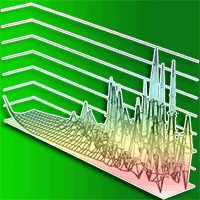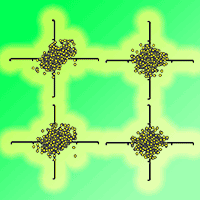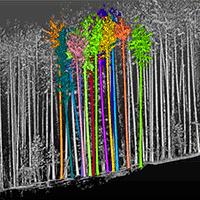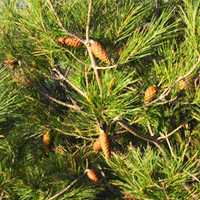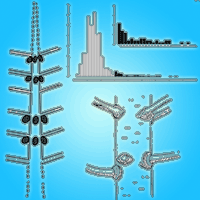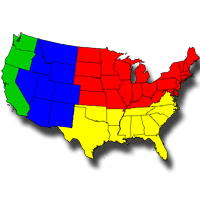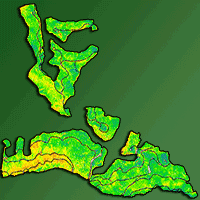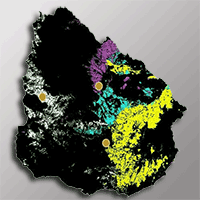
Modelling taper and stem volume considering stand density in Eucalyptus grandis and Eucalyptus dunnii
Andrés Hirigoyen (1) , Rafael Navarro-Cerrillo (2), Maurizio Bagnara (3), Jorge Franco (4), Fernando Requin (1), Cecilia Rachid-Casnati (1)
iForest - Biogeosciences and Forestry, Volume 14, Issue 2, Pages 127-136 (2021)
doi: https://doi.org/10.3832/ifor3604-014
Published: Mar 16, 2021 - Copyright © 2021 SISEF
Research Articles
Abstract
Eucalyptus grandis and Eucalyptus dunnii are the most planted tree species in Uruguay. Anticipating information about the quantity and quality of wood is important for managing intensive forest plantation. The estimate of merchantable and total wood volume is an essential tool in forest planning and management. The aim of this study was to evaluate four systems of taper and merchantable volume that consisted in a taper, a merchantable volume and a total tree volume function. A modified second-order continuous autoregressive error structure corrected the inherent serial autocorrelation of different observations in one tree. Taper and volume equations were fitted simultaneously after autocorrelation correction by full information maximum likelihood method. The segmented system proposed by Fang et al. (2000) produced the best fit as it explained more than 98% of the taper, merchantable volume and total volume variability for both species. In addition, precision of the segmented system was compared with and without incorporating stand density as a variable. Results of this analysis showed that for E. grandis, the predictive accuracy of the model was improved by including the stand density variable, whereas for E. dunnii this variable was not statistically significant. This modelling framework provides an improvement in taper and tree volume predictions for E. dunnii and E. grandis in Uruguay. The possibilities offered by this methodology could be of interest for its application in countries where fast growing plantations are managed.
Keywords
Compatible Systems, Taper, Simultaneous Estimation, Intensive Silviculture, Eucalyptus
Authors’ Info
Authors’ address
Fernando Requin
Cecilia Rachid-Casnati 0000-0002-8621-7061
National Institute of Agricultural Research (INIA) Tacuarembó, Ruta 5 km 386, Tacuarembó (Uruguay)
Department of Forestry Engineering, Laboratory of Silviculture, Dendrochronology and Climate Change, DendrodatLab- ERSAF, University of Cordoba, Campus de Rabanales, Crta. IV, km. 396, E-14071 Córdoba (Spain)
Senckenberg Biodiversity and Climate Research Centre (SBiK-F), Senckenberganlage 25, D-60325 Frankfurt am Main (Germany)
University of the Republic, Faculty of Agronomy, Paysandú (Uruguay)
Corresponding author
Paper Info
Citation
Hirigoyen A, Navarro-Cerrillo R, Bagnara M, Franco J, Requin F, Rachid-Casnati C (2021). Modelling taper and stem volume considering stand density in Eucalyptus grandis and Eucalyptus dunnii. iForest 14: 127-136. - doi: 10.3832/ifor3604-014
Academic Editor
Angelo Rita
Paper history
Received: Jul 31, 2020
Accepted: Jan 15, 2021
First online: Mar 16, 2021
Publication Date: Apr 30, 2021
Publication Time: 2.00 months
Copyright Information
© SISEF - The Italian Society of Silviculture and Forest Ecology 2021
Open Access
This article is distributed under the terms of the Creative Commons Attribution-Non Commercial 4.0 International (https://creativecommons.org/licenses/by-nc/4.0/), which permits unrestricted use, distribution, and reproduction in any medium, provided you give appropriate credit to the original author(s) and the source, provide a link to the Creative Commons license, and indicate if changes were made.
Web Metrics
Breakdown by View Type
Article Usage
Total Article Views: 38521
(from publication date up to now)
Breakdown by View Type
HTML Page Views: 30988
Abstract Page Views: 3301
PDF Downloads: 3578
Citation/Reference Downloads: 2
XML Downloads: 652
Web Metrics
Days since publication: 1756
Overall contacts: 38521
Avg. contacts per week: 153.56
Citation Metrics
Article Citations
Article citations are based on data periodically collected from the Clarivate Web of Science web site
(last update: Mar 2025)
Total number of cites (since 2021): 8
Average cites per year: 1.60
Publication Metrics
by Dimensions ©
Articles citing this article
List of the papers citing this article based on CrossRef Cited-by.
References
Conditioning diagnostics: collinearity and weak data in regression. Operational Research Society 44: 88-88.
Gscholar
Caracterización agroclimática del Uruguay 1980-2009. [Agroclimatic characterization of Uruguay 1980-2000]. Serie Técnica INIA 193. Montevideo, Uruguay, pp. 33. [in Spanish]
Gscholar
The form and taper of forest-tree stems. Imperial Forestry Institute, University of Oxford, UK, pp. 79.
Gscholar
Sistema compatible de ahusamiento-volumen comercial para plantaciones de Pinus greggii Engelm. en Hidalgo, México [Compatible tree taper and volume system for commercial plantations of Pinus greggii Engelm in Hidalgo, Mexico]. Revista Mexicana de Ciencias Forestales 8: 59-70. [in Spanish]
CrossRef | Gscholar
Tree profile equations are significantly improved when adding tree age and stocking degree: an example for Larix gmelinii in the Greater Khingan Mountains of Inner Mongolia, northeast China. European Journal of Forest Research 139: 443-458.
CrossRef | Gscholar
SAG Eucalyptus: sistema de apoyo a la gestión de Eucalyptus orientadas a la producción de celulosa en Uruguay [SAG Eucalyptus: Eucalyptus management support system aimed at the production of cellulose in Uruguay]. INIA Serie Técnica 173, Montevideo, Uruguay, pp. 26. [in Spanish]
Gscholar
Applied linear statistical models. Irwin, Chicago, IL, USA, pp. 318.
Gscholar
Mejoramiento en la calidad de la información vinculada con la utilización de la biomasa forestal [Improvement in the quality of information related to the use of forest biomass]. Producción de Electricidad a partir de Biomasa - PROBIO, Montevideo, Uruguay, pp. 157. [in Spanish]
Gscholar
Mensura Forestal [Forest Measurement]. GTZ/IICA, Serie Investigación y Educación en Desarrollo Sostenible, San José, Costa Rica. pp. 561. [in Spanish]
Gscholar
SAS/STAT user’s guide, version 9.1. SAS Institute Inc., Cary, NY, USA, pp. 128.
Gscholar
Logaritmic expression of timber-tree volume. Journal of Agricultural Research 47: 719-734.
Gscholar
Sistema de cubicación para árboles individuales de Tectona grandis L.f. mediante funciones compatibles de ahusamiento-volumen [Volume estimation system for individual Tectona grandis L.f. trees through compatible taper/volume functions]. Revista Mexicana de Ciencias Forestales 5: 58-74. [in Spanish]
CrossRef | Gscholar


